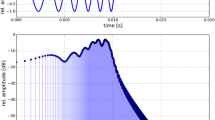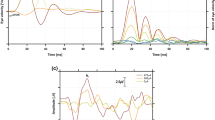Abstract
To reduce the testing time of vestibular evoked myogenic potentials (VEMP) and the physical efforts of subjects, we studied if VEMP recording by binaural simultaneous stimulation in patients with vestibulo-cochlear disorders can be applicable as a screening test. Twenty-eight patients with vestibulo-cochlear disorders (12 men and 16 women, 22 to 77 years of age) were enrolled in this study. Patients were presented with binaural or monaural click (95 dBnHL) stimulation to record VEMPs. Their VEMP responses to binaural simultaneous stimulation were compared with those of monaural individual stimulation. Twenty-six of the 28 patients (93%) showed the same results in binaural simultaneous stimulation as in monaural individual stimulation. Amplitudes of p13-n23 to binaural simultaneous stimulation showed significant correlation to those of monaural individual stimulation ( r =0.774, P <0.0001 t -test). Peak latencies of p13 and n23 of binaural simultaneous stimulation also showed significant correlation to those of monaural individual stimulation (p13: r =0.684, P <0.0001 t -test, n23: r =0.657, P <0.0001 t -test). The binaural simultaneous stimulation method for VEMP recording is applicable for patients with vestibulo-cochlear disorders as a screening test in the clinic.




Similar content being viewed by others
References
Brantberg K, Fransson PA (2001) Symmetry measures of vestibular evoked myogenic potentials using objective detection criteria. Scand Audiol 30:189–196
Colebatch JG, Halmagyi GM, Skuse NF (1994) Myogenic potentials generated by a click-evoked vestibulocollic reflex. J Neurol Neurosurg Psychiatry 57:190–197
Kushiro K, Zakir M, Ogawa Y, Sato H, Uchino Y (1999) Saccular and utricular inputs to sternoclidomastoid motoneurons of decerebrate cats. Exp Brain Res 126:410–416
Li MW, Houlden D, Tomlinson RD (1999) Click evoked EMG responses in sternocleidomastoid muscles: characteristics in normal subjects. J Vest Res 9:327–334
Murofushi T, Halmagyi GM, Yavor RA, Colebatch JG (1996) Absent vestibular evoked myogenic potentials in vestibular neurolabyrinthitis: an indicator of inferior vestibular nerve involvement? Arch Otolaryngol Head Neck Surg 122:845-848
Murofushi T, Ochiai A, Ozeki H, Iwasaki S (2004) Laterality of vestibular evoked myogenic potentials. Int J Audiol 43:66–68
Wang SJ, Young YH (2003) Vestibular evoked myogenic potentials using simultaneous binaural acoustic stimulation. Hear Res185:43–48
Author information
Authors and Affiliations
Corresponding author
Rights and permissions
About this article
Cite this article
Murofushi, T., Takai, Y., Iwasaki, S. et al. VEMP recording by binaural simultaneous stimulation in subjects with vestibulo-cochlear disorders. Eur Arch Otorhinolaryngol 262, 864–867 (2005). https://doi.org/10.1007/s00405-004-0913-y
Received:
Accepted:
Published:
Issue Date:
DOI: https://doi.org/10.1007/s00405-004-0913-y




